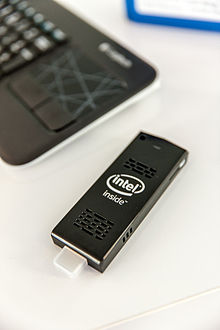Stick PC

A stick PC or PC on a stick is a single-board computer in a small elongated casing resembling a stick, that can usually can be plugged directly (without an HDMI cable) on an HDMI video port. A stick PC is a device which has independent CPU or processing chips and which does not rely on another computer. It should not be confused with passive storage devices such as thumb drives.
A stick PC can be connected to a peripheral device such as a monitor, TV, or kiosk display to produce visual or audio output.
History
Gumstix is probably the first Stick PC, since it came out in 2003. It used the ARM architecture System on a chip (SoC) and uses the Linux 2.6 kernel. Windows CE can be installed on this stick. It was created based on the idea of a PC similar in size to that of an average stick of gum.[1]
Most Stick PCs are still based on the ARM architecture.
The Stick PC was first introduced around 2003. Some examples of Stick PCs are: The Android Mini PC MK802 series from Rikomagic, using Android or GNU/Linux distributions, both based on Linux and Allwinner Technology or Rockchip SoC,[2][3][4] Cotton Candy, using Samsung Exynos SoC,[5] and the Fire TV Stick are just some examples.

In July 24 2013, Google introduced the Google Chromecast.[6][7]
In April 2013, Tronsmart released the MK908, using Rockchip RK3188 (featuring the quad-core ARM Cortex-A9 and ARM Mali-400MP GPU).[8]
In 2013, month unknown, A small chinese company called "MeeGoPad" released the very first x86 based Stick PC, featuring the Intel© Atom™ Z3735F Processor. [9]
In March 2015, Asus and Google introduced the Chromebit, a stick PC based on the Rockchip RK3288 SoC and running Google's Chrome OS.[10]

As of 2016, Intel Compute Stick is considered one of the first Intel x86 based Stick PCs.[11]
See also
References
- ^ Erik Larson. "Introduction to GumStix Computers" (PDF). University of West Florida.
- ^ Avram Piltch (October 2, 2012). "Android 4.0 Mini PC MK802 II Review". laptopmag.com.
- ^ Brad Linder (June 6, 2012). "$74 MK802 Android 4.0 Mini PC: First impressions (video)". Liliputing.com.
- ^ ames Trew (July 6, 1012). "MK802 Android 4.0 Mini PC hands-on impressions". Engadget.
- ^ Jarred Walton (January 9, 2012). "FXI Cotton Candy Demo: More Power than You Can Shake a (Thumb) Stick at". Anandtech.
- ^ David Blaza. "China Beat Google to Chromecast". EE Times.
- ^ Evangelho, Jason (July 24, 2013). "Google's Chromecast A Brilliant Play For The Living Room -- Especially With $35 Price Tag". Forbes.com. Retrieved July 24, 2013.
- ^ Brad Linder (April 25, 2013). "Tronsmart MK908 quad-core Android TV stick performance (video)". Liliputing.com.
- ^ MeeGoPad International. "MeegoPad T01 First Intel Windows TV STick". x86pad.com/.
- ^ Hollister, Sean (March 31, 2015). "Google's Chromebit Turns Any TV Into a Chrome PC for $85". Gizmodo.
- ^ Intel Compute Stick (2016) review, By: Dan Ackerman Reviewed: January 24, 2016, CNET
